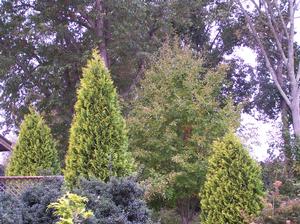Design Part III: Design Principles - Building the Garden
In the first installment of The Potting Shed we looked at the Tools of Design: form, line, texture and color. To recap, the Tools of Design are the characteristics which describe and define the plants with which we have to work. In this article we will look at the Principles of Design. Simply put: the Principles of Design are the many ways we can arrange plants. Whereas the Tools describe plant qualities, applying the Principles of Design is the manner in which you utilize the plants, expressing your artistic self upon the landscape (see pic 2).
Repetition is achieved by repeating a plant at various points in a garden room (see pic 1). This principle can help to pull together and connect other elements into a cohesive whole. Variety, closely related to repetition, can be realized by using different plants that project a similar texture or tint. Your eye will connect a creamy yellow variegated plant to a solidly creamy yellow shrub elsewhere in the garden room. One will relate to the other with natural immediacy. Form and line also do not necessarily have to be repeated using the same plant over and over again. Repetition will occur through variety if different plants of about the same size, color and form are integrated into the garden.
Balance equals visual weight within a landscape or a garden room. Think of rounded to spreading forms, finer textures and cool quiet colors as lightweights. Heavyweights are elements that draw the eye such as bold textures, vertical forms and hot to warm colors. More lightweights will be required to balance a heavyweight. A multitude of lightweights in a garden might set a dull tone, a “boring” feeling. Conversely, too many heavyweights could have the unfortunate effect of a “too busy” garden. But this may be exactly the effect you wish, for instance a border of hot-colored perennials: riotous, like a Mexican fiesta. You only need only decide beforehand the kind of garden you desire and the atmosphere you wish to create.
Emphasis can be found in numbers; that is, a large group of a single variety will provide contrast to a smaller group of differing quality. You can implement emphasis in a smaller garden using smaller numbers of a kind, more in a larger landscape. Equal emphasis may create a stolid quiet feeling, as in balance, possibly contemplative but also possibly dull. This may be exactly the feeling you want in, for example, in a transition from one busy garden room to the next like a sip of water to cleanse the palette between bites of food. Too, it may be the feeling of serenity you desire in a spot in which you would frequent to either rest, meditate or read a book. Irregular contrast will create a more dynamic, jazzy feel – lively to the eye and the spirit. Irregular emphasis will help move you through a landscape; it can be exciting.
A THEME RUNS THROUGH IT
Sequence is the manner in which one garden room connects to the next. Pick an over-arching theme that satisfies your fancy: might it be conifer, butterfly, sculpture or food garden? The implementation of sequence, a theme that runs through the entire gestalt of the landscape, will create harmony. Sequence used well will underscore an air of easy countenance as you move through a landscape. Sequence will combine individual garden rooms into a related family.
Scale is size relationships from one collection of building blocks to the next. When walking through a garden many small elements may make one feel gigantic. Many large elements will conversely make one feel small. Humans tend to feel more comfortable with plants that are about our size. Variable scale makes for a dynamic use of groups of elements, more exciting to the eye through richer use of form and line. The larger the garden, the more park-like it may become, for example, groups of trees flanked with clusters of shrubs which in turn step down to smaller shrubs or perennials. Larger trees planted with shrubs closer to our own height helps us to better relate to such a grand scheme (see pic 3). Variable scale makes for a dynamic use of groups of elements. When well-used it connects us comfortably to the landscape.
Let’s recap. One way to look at the Principles of Design as they relate to the Tools of Design is to think architecturally. The tools describe the plants which are the building blocks. Employing the principles is the way you put the building blocks together; it is how you build your garden. The manner in which you construct with the building blocks is your aesthetic expression, your personal artistic handprint upon the landscape. In the third and final installment about design we will further explore how you might employ the Tools and Principles of Design. Stay tuned.
Penned by Wayne Paquette, Winter 2008
Penned by Wayne Paquette, Winter 2012


